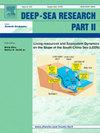解开上升流:在洪堡上升流系统中,光和养分供应如何塑造初级生产者和化学计量学
IF 3
3区 地球科学
Q2 OCEANOGRAPHY
Deep-sea Research Part Ii-topical Studies in Oceanography
Pub Date : 2025-07-29
DOI:10.1016/j.dsr2.2025.105522
引用次数: 0
摘要
洪堡上升流系统(HUS)以其非凡的生产力而闻名,这是由于风驱动的富含营养的深水上升流,导致了全球单位面积最高的渔获量。与其他东部边界上升流系统不同,东部边界上升流强度在冬季最高,初级生产力在夏季达到峰值。我们目前对上升流强度和生产力之间的反直觉关系的理解不足以预测气候变化对这一生态系统的影响。为了阐明HUS中上升流-生产力关系的驱动因素,我们验证了一个假设,即冬季低光有效性限制了初级生产力,尽管强大的上升流强度为表层提供了大量的营养物质,而夏季较浅混合层的光有效性使上升流营养物质得到有效利用。为了阐明光和营养物质对初级生产和碳循环的相互作用,我们在为期35天的中生态实验中,通过在不同上升流强度(0%、15%、30%、45%和60%)下重现夏季高光照和冬季低光照条件,封闭了卡亚奥(秘鲁)海岸附近的天然浮游生物群落。初级生产力和浮游植物生物量随硝态氮和光照有效性成比例。通过比较不同光照水平下相同的上升流强度,我们的数据证实了这样的假设,即混合层加深导致的光限制是洪堡上升流系统初级生产力非相位观测的关键驱动因素。在限光条件下,浮游植物具有较低的POC:Chla比值,表明它们已适应光环境;低POC:PON比值表明它们对硝酸盐的吸收受到光限制,从而提高了冬季食草动物的食物质量。我们的研究表明,浮游植物生物量(利用Chla估算)的小季节变化可能掩盖了初级生产力(碳吸收)的大变化,并强调了将卫星研究与现场观测和实验研究结合起来预测变化中的海洋中上升流系统命运的重要性。全球变暖导致的上升流系统(如HUS)分层增加将导致浮游植物生物量减少,而POC:Chla和POC:PON比值较高。这种浮游植物群落会降低食草动物的食物质量,并可能导致向更高营养水平转移的下降,但同时也可能导致二氧化碳排放生态系统中二氧化碳的减少。了解HUS中上升流强度与生产力之间的独特关系有助于预测这一对渔业有价值的生态系统对气候变化影响的反应。本文章由计算机程序翻译,如有差异,请以英文原文为准。
Disentangling upwelling: how light and nutrient supply shape primary producers and stoichiometry in the Humboldt upwelling system
The Humboldt upwelling system (HUS) is known for its extraordinary productivity due to wind-driven upwelling of nutrient-rich deep water, resulting in the highest fish catches per unit area worldwide. However, contrary to other Eastern boundary upwelling systems, upwelling intensity is highest in winter, while primary productivity reaches its peak during the summer months. Our current understanding of the counterintuitive relationship between upwelling intensity and productivity is insufficient to predict the consequences of climate change on this ecosystem. To elucidate the drivers of the upwelling-productivity relationship in the HUS, we tested the hypothesis that low light availability limits primary productivity in winter despite strong upwelling intensity supplying plenty of nutrients into the surface layer, while light availability in the shallower mixed layer in summer enables an effective use of the upwelled nutrients. To disentangle the interactive effects of light and nutrients on primary production and carbon cycling, we enclosed natural plankton communities off the coast of Callao (Peru) during a 35-day mesocosm experiment by recreating summer-time high light and winter-time low light conditions under different upwelling intensities (0 %, 15 %, 30 %, 45 % and 60 %). Primary productivity and phytoplankton biomass scaled with both nitrate and light availability. Comparing the same upwelling intensity at different light levels, our data confirmed the hypothesis that light limitation due to deepening of the mixed layer is a key driver for the out-of-phase observations in primary productivity in the Humboldt upwelling system. Under light limiting conditions phytoplankton had low POC:Chla ratios indicating photoacclimation and low POC:PON ratios indicating light limitation of nitrate uptake which leads to increased food quality for grazers in winter. Our study indicates that small seasonal changes in phytoplankton biomass (estimated using Chla) might hide larger changes in primary productivity (carbon uptake), and highlights the importance of combining satellite studies with in situ observations and experimental studies to predict the fate of upwelling systems in a changing ocean. Increased stratification caused by global warming in upwelling systems such as the HUS would lead to less phytoplankton biomass with higher POC:Chla and POC:PON ratios. This phytoplankton community would have lower food quality for grazers and might lead to a decline in the transfer to higher trophic levels, but at the same time might lead to increased CO2 drawdown in an otherwise CO2 emitting ecosystem. Understanding the unique relationship between upwelling intensity and productivity in the HUS contributes to predicting the reaction of this valuable ecosystem for fisheries to the impacts of climate change.
求助全文
通过发布文献求助,成功后即可免费获取论文全文。
去求助
来源期刊
CiteScore
6.40
自引率
16.70%
发文量
115
审稿时长
3 months
期刊介绍:
Deep-Sea Research Part II: Topical Studies in Oceanography publishes topical issues from the many international and interdisciplinary projects which are undertaken in oceanography. Besides these special issues from projects, the journal publishes collections of papers presented at conferences. The special issues regularly have electronic annexes of non-text material (numerical data, images, images, video, etc.) which are published with the special issues in ScienceDirect. Deep-Sea Research Part II was split off as a separate journal devoted to topical issues in 1993. Its companion journal Deep-Sea Research Part I: Oceanographic Research Papers, publishes the regular research papers in this area.

 求助内容:
求助内容: 应助结果提醒方式:
应助结果提醒方式:


